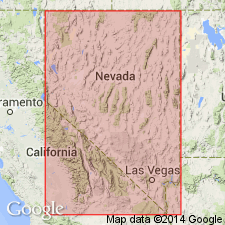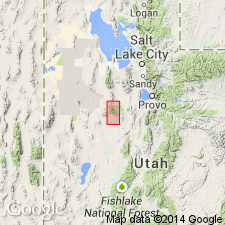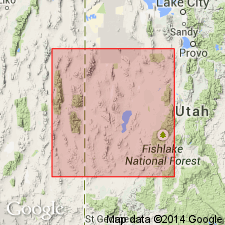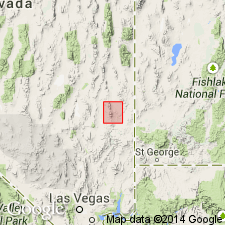
- Usage in publication:
-
- Condor member
- Modifications:
-
- Original reference
- Biostratigraphic dating
- Dominant lithology:
-
- Shale
- AAPG geologic province:
-
- Great Basin province
Summary:
Pg. 39, fig. 5. Condor member of Swasey limestone. Name applied to lowermost 117 feet of type Swasey as described by Deiss (1938). Consists largely of thinly interbedded calcareous, argillaceous, and arenaceous strata. Conformably underlies unnamed upper member of Swasey; conformably overlies Dome limestone. This unit, although more dolomitic, was referred to as Highland Peak unit "F" in Pioche district by Wheeler and Lemmon (Nevada Univ. Bull., Geol. Mining Ser., no. 31, 1939). Age is Middle Cambrian on the basis of fossils [trilobites].
Type section: in Panaca Hills, Pioche district, Lincoln Co., eastern NV. Named from Condor Canyon, about 2 mi north of type section; member exposed on north wall, near mouth of canyon. Notable exposures in Wah Wah Mountains and House Range, UT.
Source: US geologic names lexicon (USGS Bull. 1200, p. 909); GNU records (USGS DDS-6; Menlo GNULEX).

- Usage in publication:
-
- Condor formation
- Modifications:
-
- Revised
- AAPG geologic province:
-
- Great Basin province
- South Western Overthrust
Summary:
Pg. 12 (table 1), 35, 46-47, pl. 1, measured sections. Condor formation of Ophir group. Described in Sheeprock Mountains, Tooele and Juab Counties, Wasatch National Forest, western Utah, rank raised to formation in Ophir group. Thickness 107 to 135 feet. Overlies Dome limestone. [Age is Middle Cambrian.]
Source: US geologic names lexicon (USGS Bull. 1200, p. 909).

- Usage in publication:
-
- Condor member
- Condor formation
- Modifications:
-
- [Not used]
- AAPG geologic province:
-
- Great Basin province
Summary:
Pg. 47, 51. Condor member of Swasey limestone of Wheeler (1948); Condor formation of Ophir group of Cohenour (1959). Name replaced with Whirlwind Formation (new). [See entry under Whirlwind.]
Source: US geologic names lexicon (USGS Bull. 1200, p. 909).

- Usage in publication:
-
- Condor Member*
- Modifications:
-
- Revised
- Adopted
- AAPG geologic province:
-
- Great Basin province
Summary:
Pg. 34 (table 5), 44 (fig. 12), 45-46. Condor Member of Highland Peak Formation. Is most distinctive map unit of Highland Park Formation. = Highland Peak "F" of Wheeler and Lemmon (1939) and "Platy dolomite" of mining companies. Typically exposed in the Warm Spring reference section northeast of Panaca, where it is 105 feet thick. Consists of impure silty dolomites and dolomitic limestones, calcareous silty sandstones, and fine-grained limestones. Dark-gray and black chert nodules are present but not abundant. Three measured sections give an average thickness of 112 feet. Conformably overlies Step Ridge Member; conformably underlies Meadow Valley Member; both of Highland Peak Formation. Age is Middle Cambrian, based on stratigraphic position.
[Condor Member of Highland Peak Formation, as recognized in Pioche district, Lincoln Co., NV, adopted by the USGS (GNC index card files, USGS-Menlo, USGS-Reston; GNC changes in geologic nomenclature, unpub., Jan. 1, 1962-June 30, 1962, p. 14).]
[Wheeler (1948) miscorrelated type Condor beds with shaly beds in lower part of Swasey Limestone of House Range, central western Utah. The shaly beds in the lower part of Wheeler's Swasey = Whirlwind Formation of Robison (Intermountain Assoc. Petrol. Geol. Gdbk., 11th Ann. Field Conf., 1960) and Hintze and Robison (GSA Bull., v. 86, no. 7, 1975).]
Source: Publication; GNU records (USGS DDS-6; Menlo GNULEX); GNC index card files (USGS-Menlo; USGS-Reston).
For more information, please contact Nancy Stamm, Geologic Names Committee Secretary.
Asterisk (*) indicates published by U.S. Geological Survey authors.
"No current usage" (†) implies that a name has been abandoned or has fallen into disuse. Former usage and, if known, replacement name given in parentheses ( ).
Slash (/) indicates name conflicts with nomenclatural guidelines (CSN, 1933; ACSN, 1961, 1970; NACSN, 1983, 2005, 2021). May be explained within brackets ([ ]).

